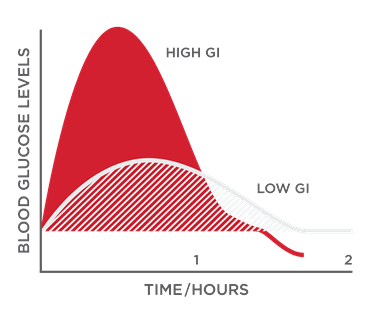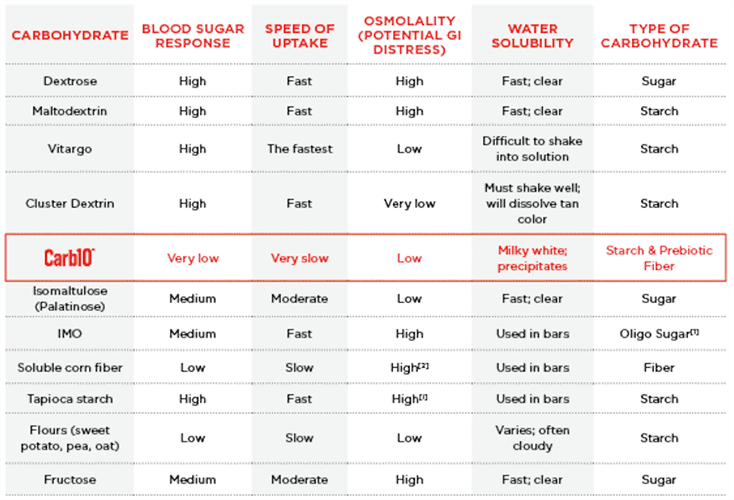How to Formulate Supplements with Carbs

In order to understand intraworkouts, we need to come to terms with carbs vs. no carbs. Carbs are quickly becoming the “new bad guy” in the American diet. We’re just a few years away from anti-carbohydrate campaigns, and the popularity of low-carb and ketogenic lifestyles are only growing. In this shifting environment, how do you formulate supplements with carbs?
Carb Considerations in Intraworkouts
There are four key things to consider before you formulate with carbs especially in the intraworkout conversation: glycemic index, carbohydrate types, tolerability and health impacts.
The Glycemic Index is a measure of a food’s impact on post-prandial blood glucose. In other words, “how much will this food increase my blood glucose after I eat it, on a scale from 0 to 100?”
Increasing blood glucose by consuming a high glycemic carb is a desirable quality of a carbohydrate source during or immediately prior to certain types of athletic activity – namely those that require a quick burst of semi-sustained energy substrate, such as soccer. High-glycemic carbs may also be utilized post-activity to quickly replenish glycogen stores, but this tactic is only appropriate if the athlete is going to be using the same muscle groups again within 24 hours, such as in tournament-style competitions.
For ALL other times, a low-glycemic food item is more desirable.

Carbohydrate types are classified as monosaccharides, disaccharides, oligosaccharides, and polysaccharides. In the supplement world, we primarily deal with monosaccharides (like glucose or fructose) and polysaccharides (starches). Although they are technically different types of carbohydrates, they are not always so different in their biological effects. Of particular interest is maltodextrin. Maltodextrin is classified as a starch, but its biological behavior mimics that of pure glucose in many regards. In effect, this starch is a sugar and carries with it all of the negative aspects of a sugar.
The tolerability of a carbohydrate powder is linked to its gastrointestinal (GI) effects. In this regard, we must consider osmolality and molecular weight. The two are inversely related, meaning as one increases, the other decreases. Low osmolality (and high molecular weight) are associated with rapid gastric emptying time and minimal, if any, GI distress.
Health impacts related to carbohydrates are, most notably, glucose and insulin levels. Although carbohydrates are still purported to be the foundation of a healthy diet, more sophisticated research is soon to dethrone them. The reasoning behind this is as follows:
• elevated post-prandial blood glucose drastically increases risk for cardiovascular disease1
• dietary carbohydrate restriction is superior to dietary saturated fat restriction for improving diabetes and heart disease2
• and glucose is the major fuel source for many cancer cells3
These are also the underlying reasons for the relevance of the Glycemic Index.
6 Rules of Thumb for Formulating Supplements with Carbs
1. Be cautious about formulating with anything labeled as maltodextrin or “glucose polymers” (euphemism for maltodextrin). The reasons are (1) it is known as a cheap filler (2) it disrupts the gut microbiome4,5 and (3) consumers are gaining knowledge about the negative health impacts of elevated insulin6.
2. Lower glycemic carbs providing sustained energy should be used in most applications, particularly meal replacements, pre- and intra-workout products.
3. Higher glycemic carbs should only be used proximal in time to athletic activity.
4. Use “cleaner” carbs that are non-gmo, non-allergenic, organic, and that minimally impact blood sugar.
5. Remain wary of the negative health impacts of carbohydrates and formulate to reflect the purpose of the product.
6. Pay attention to osmolality. This is often forgotten, but so critical in preventing GI distress.
Applications for Carbohydrate Powders such as Carb10™
Clean Gainer (i.e. Optimum’s Gold Standard Gainer)
Carb-only
Pre-Workout
Intra-Workout
Post-Workout
Click here to learn more about Carb10™, our clean, easy-to-digest, low-glycemic solution.
How do Carbohydrates Compare?

References:
1. Glucose tolerance and cardiovascular mortality: comparison of fasting and 2-hour diagnostic criteria. Arch Intern Med. 2001;161(3):397-405.
2. Volek, J. S., & Feinman, R. D. (2005). Carbohydrate restriction improves the features of Metabolic Syndrome. Metabolic Syndrome may be defined by the response to carbohydrate restriction. Nutrition & metabolism, 2(1), 1.
3. Seyfried, T.N., & Shelton, L.M. (2010). Cancer as a metabolic disease. Nutrition & Metabolism, 7(1), 1.
4. Nickerson, K. P., Chanin, R., & McDonald, C. (2015). Deregulation of intestinal anti-microbial defense by the dietary additive, maltodextrin. Gut microbes, 6(1), 78-83.
5. O’Brien, W. J., & Rowlands, D. S. (2011). Fructose-maltodextrin ratio in a carbohydrate-electrolyte solution differentially affects exogenous carbohydrate oxidation rate, gut comfort, and performance. American Journal of Physiology-Gastrointestinal and Liver Physiology, 300(1), G181-G189.
6. Blaak EE, Antoine JM, Benton D, et al. Impact of postprandial glycaemia on health and prevention of disease. Obesity Reviews. 2012;13(10):923-84.






Comments are closed here.